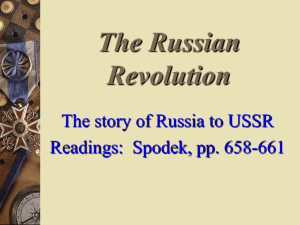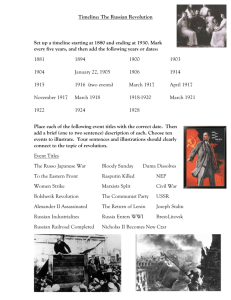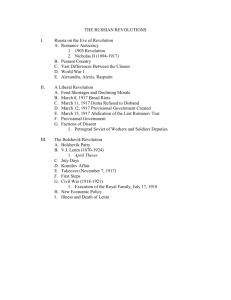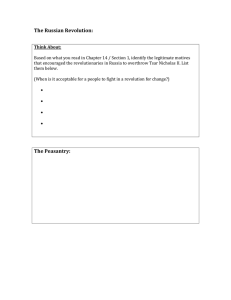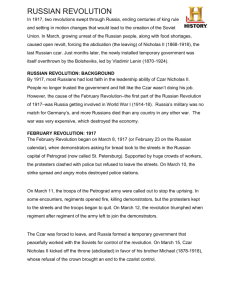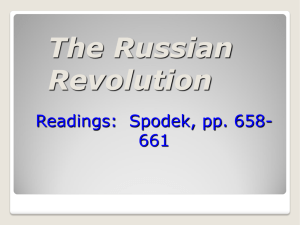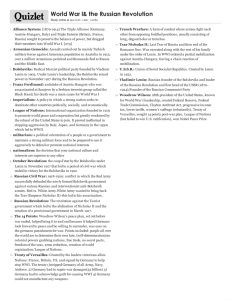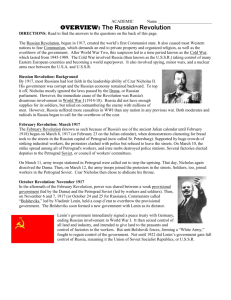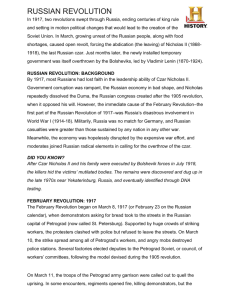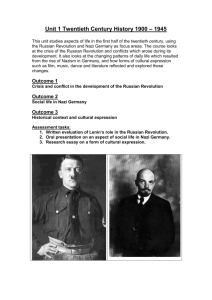Reading Guide - Chapter 18, "The Russian Revolution,"
advertisement
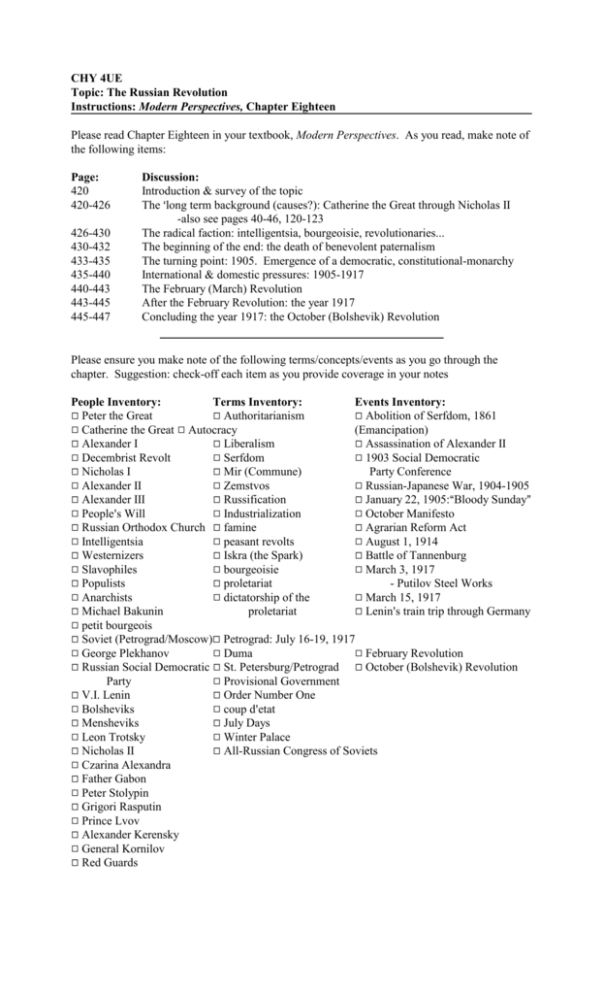
CHY 4UE Topic: The Russian Revolution Instructions: Modern Perspectives, Chapter Eighteen Please read Chapter Eighteen in your textbook, Modern Perspectives. As you read, make note of the following items: Page: 420 420-426 426-430 430-432 433-435 435-440 440-443 443-445 445-447 Discussion: Introduction & survey of the topic The >long term background (causes?): Catherine the Great through Nicholas II -also see pages 40-46, 120-123 The radical faction: intelligentsia, bourgeoisie, revolutionaries... The beginning of the end: the death of benevolent paternalism The turning point: 1905. Emergence of a democratic, constitutional-monarchy International & domestic pressures: 1905-1917 The February (March) Revolution After the February Revolution: the year 1917 Concluding the year 1917: the October (Bolshevik) Revolution Please ensure you make note of the following terms/concepts/events as you go through the chapter. Suggestion: check-off each item as you provide coverage in your notes People Inventory: Terms Inventory: Events Inventory: Peter the Great Authoritarianism Abolition of Serfdom, 1861 Catherine the Great Autocracy (Emancipation) Alexander I Liberalism Assassination of Alexander II Decembrist Revolt Serfdom 1903 Social Democratic Nicholas I Mir (Commune) Party Conference Alexander II Zemstvos Russian-Japanese War, 1904-1905 Alexander III Russification January 22, 1905:ABloody Sunday@ People=s Will Industrialization October Manifesto Russian Orthodox Church famine Agrarian Reform Act Intelligentsia peasant revolts August 1, 1914 Westernizers Iskra (the Spark) Battle of Tannenburg Slavophiles bourgeoisie March 3, 1917 Populists proletariat - Putilov Steel Works Anarchists dictatorship of the March 15, 1917 Michael Bakunin proletariat Lenin=s train trip through Germany petit bourgeois Soviet (Petrograd/Moscow) Petrograd: July 16-19, 1917 George Plekhanov Duma February Revolution Russian Social Democratic St. Petersburg/Petrograd October (Bolshevik) Revolution Party Provisional Government V.I. Lenin Order Number One Bolsheviks coup d=etat Mensheviks July Days Leon Trotsky Winter Palace Nicholas II All-Russian Congress of Soviets Czarina Alexandra Father Gabon Peter Stolypin Grigori Rasputin Prince Lvov Alexander Kerensky General Kornilov Red Guards Part B: 1) A village council / commune ______________________ (mir). 2) peasants-turned-seasonal-workers in mines, construction, or towns, migrating from the countryside ______________________ (otkhodniki) 3) The theorist / observer of the Russian political scene who determined that workers were capable only of achieving Atrade union consciousness@ ______________________ (Lenin) 4) Czarist Minister of Trade and Industry who initiated vast modernisation and industrialisation initiatives ______________________ (Sergei Witte) 5) The dominant manifestation of Russian radical thought throughout 1860s-1880s; They held the view that industrialisation and urbanisation had caused degradation within the social fabric of Western countries, and thus argued that similar developments should be avoided at all costs (populists) within Russia: ______________________ (populism) 6) The term imposed on the faction of the splintered Russian Social Democratic Workers= Party in which Plekanov, Trotsky, and Martov were members: ______________________ (Menshevik) 7) The term given by Lenin to the leadership within the revolutionary party, armed with the most advanced, revolutionary ideology ______________________ (vanguard fighter) 8) This organisation was to provide the city with a kind of emergency municipal government when other institutions were paralysed and in the event of a general strike. ______________________ (St. Petersburg soviet) 9) The closest Russia came to a Constitution, this document was entitled: ______________________ (the fundamental laws of 1906) 10) The title of Lenin=s 1902 polemic document in which he set forth the theoretical foundation for the >dictatorship of the proletariat= ___________________________________________


